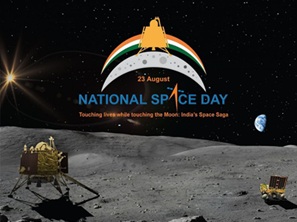Why in News ?
The second National Space Day celebrated on 23 August in India is especially in the news in 2025 as it marks the second anniversary of the historic success of the Chandrayaan-3 mission. The day was declared as National Space Day by Prime Minister Narendra Modi to commemorate the successful landing of ISRO’s Chandrayaan-3 lander on the surface of the Moon in 2023. Its main objective is to commemorate the success of the Chandrayaan-3 mission and inspire the youth to pursue careers in science, technology, engineering and mathematics (STEM).

Second National Space Day (2025)
Historical Background
- On 23 August 2023, ISRO’s Chandrayaan-3 mission made a successful soft landing near the South Pole of the Moon.
- It included the deployment of the Vikram lander and Pragyan rover, making India the fourth country to achieve this historic feat and the first to land near the South Pole of the Moon.
- Its landing site is known as the “Shiva Shakti” point.
- Commemorating this achievement, 23 August was officially declared as “National Space Day” by Prime Minister Narendra Modi.
- The first National Space Day was organized on 23 August 2024, with the theme: “Touching Lives by Touching the Moon: India's Space Story”
India's space achievements: Aryabhatta to Gaganyaan
1. Early foundations (1960–70)
- 1962 – INCOSPAR established: Dr. Vikram Sarabhai formed the Indian National Committee for Space Research (INCOSPAR) for space research.
- 1969 – ISRO established: Formed on 15 August 1969; it is India's space agency today.
- 1975 – Aryabhatta:
- India's first satellite.
- Launched into orbit by a Cosmos-3M rocket from the Soviet Union.
- This marked India's first foray into satellite technology.
2. Indigenous Rocket and Satellite Era (1980-90)
- 1980 – Rohini Satellite :
- Launched from Sriharikota by SLV-3 rocket.
- It was India’s first indigenous rocket that successfully put a satellite in orbit.
- 1984 – Rakesh Sharma :
- First Indian to go to space under Intercosmos programme with Soviet Union.
3. Progress and Strength (1990-2000)
- INSAT Series :
- Satellite constellation for telecommunication, weather, TV broadcasting and disaster management for India.
- IRS Series :
- Series of earth observation (remote sensing) satellites.
- Used in agriculture, mineral, forest and water resource management.
- 1994 – PSLV (Polar Satellite Launch Vehicle) :
- Reliable launch vehicle to carry satellites in polar orbit.
- Later this PSLV became known as the workhorse of ISRO.
4. Exploration and Space Science (2000-10)
- 2001 – GSLV (Geosynchronous Satellite Launch Vehicle):
- Developed the capability to carry heavy satellites to high orbit (geostationary orbit).
- 2008 – Chandrayaan-1:
- India's first lunar mission.
- Discovered water molecules on the surface of the moon - which surprised the whole world.
- India's name shone in space exploration.
5. Global recognition (2010-20)
- 2013 – Mangalyaan:
- India's first Mars mission.
- Features: Successful in the first attempt and the cost was the lowest (~ Rs 450 crore).
- India is the first country in Asia and the fourth country in the world to reach Mars.
- 2014 – GSLV Mk-III (now LVM-3):
- India’s most powerful rocket.
- Base for satellite launch and manned missions.
- 2017 – PSLV-C37:
- World record by launching 104 satellites in one go.
6. New heights and self-reliance (2020-present)
- 2019 – Chandrayaan-2:
- Partial success, but orbiter still functional and sending valuable data.
- 2022 – SSLV (Small Satellite Launch Vehicle):
- Affordable launcher for small satellites.
- 2023 – Chandrayaan-3:
- India becomes the fourth country to make a successful soft landing on the moon.
- First country in the world to land on the South Pole.
- The landing site got the name – Shiva Shakti Bindu.
- 2023 – Aditya L1 Mission:
- India's first space observatory mission to study the Sun.
- 2024 – Space Hackathon and Entry of Private Companies:
- Private sector along with ISRO is now involved in the space race.
7. Proposed
- 2025 – Gaganyaan Mission (Expected):
- This is India's first human space mission.
- Under this mission, a team of 3 people will be sent to space for 3 days.
- This mission will orbit the Earth at an altitude of 300-400 km from the Earth.
- After this, this team will be brought back safely to Earth.
- It is planned to be launched by the Indian Space Research Organization (ISRO) in the year 2025.
- Its objective is to demonstrate indigenous capability to launch human space flight missions to low Earth orbit (LEO).
8. Future roadmap:
- Recently, Science and Technology Minister Dr. Jitendra Singh outlined the government's space ambitions during a special discussion in the Lok Sabha; according to him, the government aims to-
- Establish a functional Indian space station by 2035
- Send Indian crew to the Moon by 2040
|
Q. On which date is National Space Day celebrated in India ?
(a) 15 August
(b) 23 August
(c) 5 July
(d) 22 October
|



